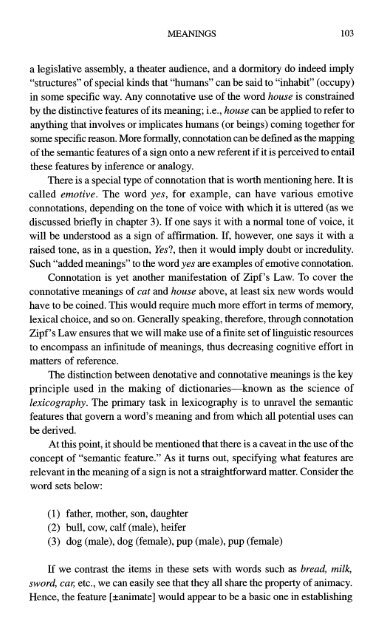A Basic Course in Anthropological Linguistics (Studies in Linguistic ...
A Basic Course in Anthropological Linguistics (Studies in Linguistic ...
A Basic Course in Anthropological Linguistics (Studies in Linguistic ...
You also want an ePaper? Increase the reach of your titles
YUMPU automatically turns print PDFs into web optimized ePapers that Google loves.
MEANINGS 103<br />
a legislative assembly, a theater audience, and a dormitory do <strong>in</strong>deed imply<br />
“structures” of special k<strong>in</strong>ds that “humans” can be said to “<strong>in</strong>habit” (occupy)<br />
<strong>in</strong> some specific way, Any connotative use of the word house is constra<strong>in</strong>ed<br />
by the dist<strong>in</strong>ctive features of its mean<strong>in</strong>g; i.e., house can be applied to refer to<br />
anyth<strong>in</strong>g that <strong>in</strong>volves or implicates humans (or be<strong>in</strong>gs) corn<strong>in</strong>g together for<br />
some speclfic reason. More formally, connotation can be def<strong>in</strong>ed as the mapp<strong>in</strong>g<br />
of the semantic features of a sign onto a new referent if it is perceived to entail<br />
these features by <strong>in</strong>ference or analogy.<br />
There is a special type of connotation that is worth mention<strong>in</strong>g here. It is<br />
called emotive. The word yes, for example, can have various emotive<br />
connotations, depend<strong>in</strong>g on the tone of voice with which it is uttered (as we<br />
discussed briefly <strong>in</strong> chapter 3). If one says it with a normal tone of voice, it<br />
will be understood as a sign of affirmation. If, however, one says it with a<br />
raised tone, as <strong>in</strong> a question, Yes?, then it would imply doubt or <strong>in</strong>credulity.<br />
Such “added mean<strong>in</strong>gs” to the word yes are examples of emotive connotation.<br />
Connotation is yet another manifestation of Zipf’s Law. To cover the<br />
connotative mean<strong>in</strong>gs of cat and house above, at least six new words would<br />
have to be co<strong>in</strong>ed. This would require much more effort <strong>in</strong> terms of memory,<br />
lexical choice, and so on. Generally speak<strong>in</strong>g, therefore, through connotation<br />
Zipf’s Law ensures that we will make use of a f<strong>in</strong>ite set of l<strong>in</strong>guistic resources<br />
to encompass an <strong>in</strong>f<strong>in</strong>itude of mean<strong>in</strong>gs, thus decreas<strong>in</strong>g cognitive effort <strong>in</strong><br />
matters of reference.<br />
The dist<strong>in</strong>ction between denotative and connotative mean<strong>in</strong>gs is the key<br />
pr<strong>in</strong>ciple used <strong>in</strong> the mak<strong>in</strong>g of dictionaries-known as the science of<br />
lexicography. The primary task <strong>in</strong> lexicography is to unravel the semantic<br />
features that govern a word’s mean<strong>in</strong>g and from which all potential uses can<br />
be derived.<br />
At this po<strong>in</strong>t, it should be mentioned that there is a caveat <strong>in</strong> the use of the<br />
concept of “semantic feature.” As it turns out, specify<strong>in</strong>g what features are<br />
relevant <strong>in</strong> the mean<strong>in</strong>g of a sign is not a straightforward matter. Consider the<br />
word sets below:<br />
(1) father, mother, son, daughter<br />
(2) bull, cow, calf (male), heifer<br />
(3) dog (male), dog (female), pup (male), pup (female)<br />
If we contrast the items <strong>in</strong> these sets with words such as bread, milk,<br />
sword, car, etc., we can easily see that they all share the property of animacy.<br />
Hence, the feature [*animate] would appear to be a basic one <strong>in</strong> establish<strong>in</strong>g






